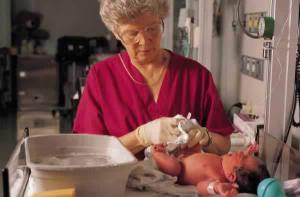Last Updated: April 2, 2013
 Gone are the days when children were considered to be “little adults”. Thanks to the advent of cytochrome P450 (CYP) enzymes and detailed knowledge of pediatric metabolism, we now know that absorption, distribution, metabolism, and excretion (ADME) functions of adults differs highly from that of newborn children (neonates). But in what ways? The following is a guide that explains the differences and considerations that should be taken in a pediatric population:
Gone are the days when children were considered to be “little adults”. Thanks to the advent of cytochrome P450 (CYP) enzymes and detailed knowledge of pediatric metabolism, we now know that absorption, distribution, metabolism, and excretion (ADME) functions of adults differs highly from that of newborn children (neonates). But in what ways? The following is a guide that explains the differences and considerations that should be taken in a pediatric population:
Absorption & Distribution
Neonates have an elevated gastric pH. The average pH of the stomach is 1.5 to 3.5. Given that the pH of a neonate is greater than this, and that the pH scale is a logarithmic scale, an increase in pH from 3 to 5 represents a 102 (100 times) increase in the ratio of base: acid in the stomach. The gastric pH of neonates can be elevated to up to 6 or 7! This elevated pH will cause the stomach to become weakly acidic. Using the principles of chemistry, weak bases such as penicillin will have a higher concentration and weak acids such as Phenobarbital will have a lower concentration. The GI tract of a neonate will also have low motility, resulting in a decreased ability to absorb lipophilic medications.
Delivery of topical medications can also be impaired in neonates. The transdermal route is not an ideal option, due to the presence of an underdeveloped straum corneum (outermost layer of the skin). Intramuscular delivery is also not an ideal option. When compared to adults, termed newborns have a higher body fat percentage. Due to this decreased muscle mass, intramuscular absorption cannot be predicted and can even result in pain for the patient!
It appears then, that intravenous delivery is the ideal option for neonates. However, due to a higher body percentage of water, delivery of hydrophilic drugs to the site of action is often prolonged or incomplete. It is not uncommon for physicians and nurses to assume that the medication is not reaching the patient. However, this assumption could prove fatal to the patient if the provider continues to give additional doses of medications with a small therapeutic index. In such scenarios, pharmacists have an opportunity to intervene. Pharmacists can inform physicians and nurses that the effects of the medication are not immediately evident due to the increased volume of distribution in the neonate.
Metabolism
The comparative metabolism of children variously differs from that of adults; based upon the enzyme and biochemical pathway affected. For example, higher weight corrected doses are needed for medications that are metabolized to their active form by CYP1A2, 2C9, and 3A4. Conversely, similar doses for children and adults are needed for medications that are excreted renally, metabolized by 2C19, 2D6, N-acetyltransferase, and uridine diphosphate glucurondsyltransferase. In the meantime, drugs that are metabolized to their active form by CYP1A2, 2C9, and 3A4; as well as those with a high first pass metabolism will have decreased bioavailability. It should be noted though, that by the age of 5 years, the bioavailablity of drugs that are metabolized by efflux transporters, such as PGP, will be equivalent to that of adults.
Excretion
The renal function of newborns cannot be estimated using traditional methods such as the Crockcoft-Gault equation. This is due to the fact that infants have a decreased glomerular filtration rate; thus renal function will not approach adult values until 8-12 months of age. Currently, the best estimate of renal function in pediatrics is the Schwartz equation:
Found an error in this article? Please contact us!
Last updated April 2013
Source(s):
http://www.nlm.nih.gov/medlineplus/ency/article/003883.htm
Anderson, Gail & Lynne, Anne. Optimizing pediatric dosing: a developmental pharmacologic approach. Pharmacotherapy.2009. 29:6; 680 – 690.

